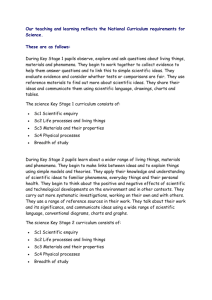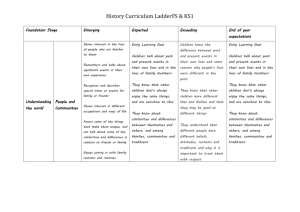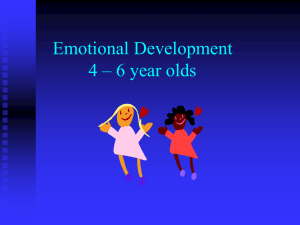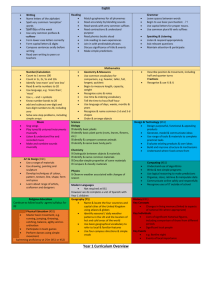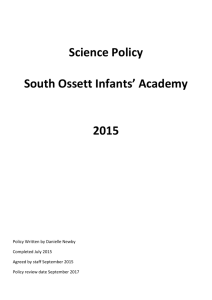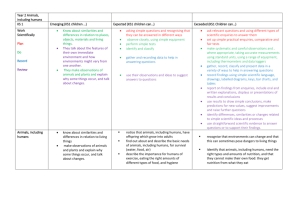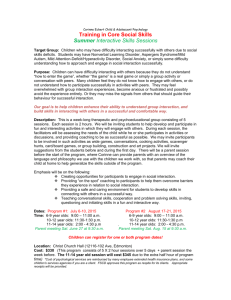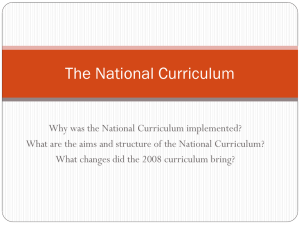Resource
advertisement
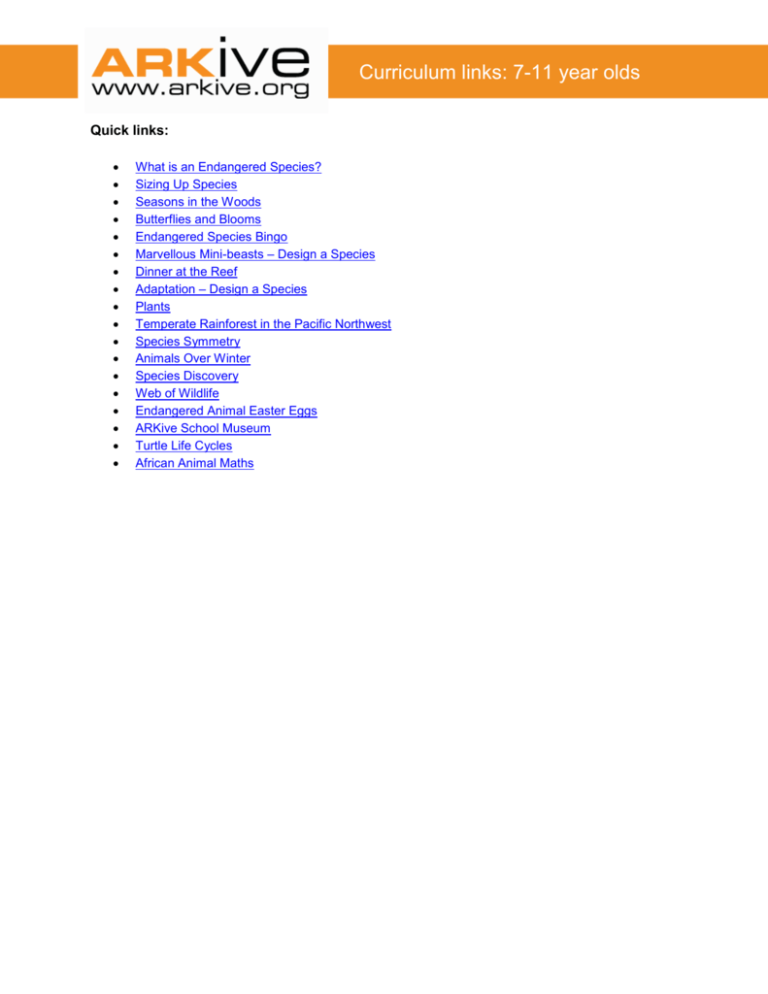
Curriculum links: 7-11 year olds Quick links: What is an Endangered Species? Sizing Up Species Seasons in the Woods Butterflies and Blooms Endangered Species Bingo Marvellous Mini-beasts – Design a Species Dinner at the Reef Adaptation – Design a Species Plants Temperate Rainforest in the Pacific Northwest Species Symmetry Animals Over Winter Species Discovery Web of Wildlife Endangered Animal Easter Eggs ARKive School Museum Turtle Life Cycles African Animal Maths Curriculum links: 7-11 year olds What is an Endangered Species? Learning outcomes: Students will learn what an endangered species is, why species are becoming endangered, where endangered species can be found and what can be done to help. This activity was designed for 7-11 year olds but many of the themes also fit with the KS1 Curriculum so it could be used with the upper KS1 students with more guidance. Key Stage 1 - Science Sc1 Scientific enquiry Planning (a, b) Obtaining and presenting evidence (g) Considering evidence and evaluating (j) Sc2 Life Processes & Living Things Humans and other animals (a, b, e, f) Variation & Classification (b) Living things in their environment (a, b, c) Key Stage 2 - Science Sc1 Scientific enquiry Ideas and evidence in science (a) Planning (b) Obtaining and presenting evidence (f, h) Considering evidence and evaluating (I, j, l, m) Sc2 Life Processes & Living Things Life processes (c) Variation & Classification (c) Living things in their environment (a, b, c) Curriculum links: 7-11 year olds Sizing Up Species Learning outcomes: Students will learn about the variety of species heights and lengths while practicing estimation, measurement and comparison skills. This activity was designed for 7-11 year olds but many of the themes also fit with the KS1 Curriculum so it could be used with the upper KS1 students with more guidance. Key Stage 1 - Science Sc1 Scientific enquiry Planning (a, b) Obtaining and presenting evidence (g) Considering evidence and evaluating (h, i, j) Sc2 Life Processes & Living Things Life processes (b) Humans and other animals (a, b, f) Variation & Classification (b) Living things in their environment (c) Key Stage 2 - Science Sc1 Scientific enquiry Ideas and evidence in science (a) Planning (b, c) Obtaining and presenting evidence (e, f, h) Considering evidence and evaluating (I, j, l, m) Sc2 Life Processes & Living Things Life processes (c) Variation & Classification (c) Living things in their environment (b, c) Curriculum links: 7-11 year olds Seasons in the Woods Learning outcomes: Students explore the concepts of migration, hibernation and adaptation to the cold in woodland species as mechanisms to survive the winter. In this activity, students will focus on species found in Wisconsin’s Northwoods, USA. This activity was designed for 7-11 year olds but many of the themes also fit with the KS1 Curriculum so it could be used with the upper KS1 students with more guidance. Key Stage 1 - Science Sc1 Scientific enquiry Planning (a, b) Obtaining and presenting evidence (g) Considering evidence and evaluating (j) Sc2 Life Processes & Living Things Life processes (b, c) Humans and other animals (a, b, f) Green Plants (a, c) Variation & Classification (b) Living things in their environment (a, b, c) Key Stage 2 - Science Sc1 Scientific enquiry Ideas and evidence in science (a) Obtaining and presenting evidence (f, h) Considering evidence and evaluating (i, j, l) Sc2 Life Processes & Living Things Life processes (a, b, c) Variation & Classification (b, c) Living things in their environment (a, b, c) Curriculum links: 7-11 year olds Butterflies and Blooms Learning outcomes: Students study the relationships between a selection of summer flowering plants and the butterflies that depend on them. In this activity, students will focus on species found in Wisconsin’s Northwoods, USA. This activity was designed for 7-11 year olds but many of the themes also fit with the KS1 Curriculum so it could be used with the upper KS1 students with more guidance. Key Stage 1 - Science Sc1 Scientific enquiry Planning (a, b) Obtaining and presenting evidence (g) Considering evidence and evaluating (i, j) Sc2 Life Processes & Living Things Life processes (b, c) Humans and other animals (a, b, f) Green Plants (a, c) Variation & Classification (b) Living things in their environment (a, b, c) Key Stage 2 - Science Sc1 Scientific enquiry Ideas and evidence in science (a) Obtaining and presenting evidence (f, h) Considering evidence and evaluating (i, j, l) Sc2 Life Processes & Living Things Life processes (a, b, c) Variation & Classification (b, c) Living things in their environment (a, b, c) Curriculum links: 7-11 year olds Endangered Species Bingo Learning outcomes: Students are introduced to the definition of an endangered species and a variety of endangered species around the world via Endangered Species Bingo. This activity was designed for 7-11 year olds but many of the themes also fit with the KS1 Curriculum so it could be used with the upper KS1 students with more guidance. Key Stage 1 - Science Sc1 Scientific enquiry Planning (a, b) Obtaining and presenting evidence (g) Sc2 Life Processes & Living Things Humans and other animals (e) Variation & Classification (b) Living things in their environment (c) Key Stage 2 - Science Sc1 Scientific enquiry Obtaining and presenting evidence (f) Considering evidence and evaluating (i, j, l) Sc2 Life Processes & Living Things Life processes (c) Variation & Classification (c) Living things in their environment (a, b, c) Curriculum links: 7-11 year olds Marvellous Mini-beasts – Design a Species Learning outcomes: Students will learn about different types of mini-beasts and their various adaptations. This activity was designed for 7-11 year olds but many of the themes also fit with the KS1 Curriculum so it could be used with the upper KS1 students with more guidance. Key Stage 1 - Science Sc1 Scientific enquiry Planning (a, b) Obtaining and presenting evidence (g) Considering evidence and evaluating (h, j) Sc2 Life Processes & Living Things Life processes (b, c) Humans and other animals (a, b, f, g) Variation & Classification (b) Living things in their environment (a, b, c) Key Stage 2 - Science Sc1 Scientific enquiry Ideas and evidence in science (a) Planning (c) Obtaining and presenting evidence (f, h) Considering evidence and evaluating (i, j, l, m) Sc2 Life Processes & Living Things Life processes (a, c) Humans and other animals (e) Variation & Classification (b, c) Living things in their environment (a, b, c, e) Curriculum links: 7-11 year olds Dinner at the Reef Learning outcomes: Students learn about food chains in a marine environment, predator‐prey relationships and the fine balance of an ecosystem. This activity was designed for 7-11 year olds but many of the themes also fit with the KS1 Curriculum so it could be used with the upper KS1 students with more guidance. Key Stage 1 - Science Sc1 Scientific enquiry Planning (a, b) Obtaining and presenting evidence (g) Considering evidence and evaluating (i, j) Sc2 Life Processes & Living Things Life processes (b) Humans and other animals (a, b, e, f) Variation & Classification (b) Living things in their environment (a, b, c) Key Stage 2 - Science Sc1 Scientific enquiry Ideas and evidence in science (a) Planning (b) Obtaining and presenting evidence (f, h) Considering evidence and evaluating (i, j, l) Sc2 Life Processes & Living Things Life processes (a, c) Variation & Classification (b, c) Living things in their environment (a, b, c, d, e) Curriculum links: 7-11 year olds Adaptation – Design a Species Learning outcomes: By creating and designing a new species, students will learn how animals are adapted to survive in different habitats. This activity was designed for 7-11 year olds but many of the themes also fit with the KS1 Curriculum so it could be used with the upper KS1 students with more guidance. Key Stage 1 - Science Sc1 Scientific enquiry Planning (a, b) Obtaining and presenting evidence (g) Considering evidence and evaluating (h, j) Sc2 Life Processes & Living Things Life processes (b, c) Humans and other animals (a, b, f, g) Variation & Classification (b) Living things in their environment (a, b, c) Key Stage 2 - Science Sc1 Scientific enquiry Ideas and evidence in science (a) Planning (c) Obtaining and presenting evidence (f, h) Considering evidence and evaluating (i, j, l, m) Sc2 Life Processes & Living Things Life processes (a, c) Humans and other animals (e) Variation & Classification (b, c) Living things in their environment (a, b, c, e) Curriculum links: 7-11 year olds Plants Learning outcomes: Students will learn about the different parts of the plant and what each part does, as well as about seeds and their different dispersal methods. They will learn what a plant needs in order to grow, and how to test the effects of food, light and warmth on plant growth. This activity was designed for 7-11 year olds but many of the themes also fit with the KS1 Curriculum so it could be used with the upper KS1 students with more guidance. Key Stage 1 - Science Sc1 Scientific enquiry Planning (a, b, c, d) Obtaining and presenting evidence (f) Sc2 Life Processes & Living Things Green plants (a, b, c) Key Stage 2 - Science Sc1 Scientific enquiry Ideas and evidence in Science (b) Planning (a, b, c, d) Obtaining and presenting evidence (e, f, h) Considering evidence and evaluating (i, j, k, l) Sc2 Life Processes & Living Things Life processes (b) Growth and nutrition (a, b, c) Curriculum links: 7-11 year olds Temperate rainforest in the Pacific Northwest Learning outcomes: Students will investigate ecosystems and understand that they include living and non-living things. Students will develop basic food chains, and will become aware that plants and animals depend on each other and on the non-living resources in their ecosystem to survive. Students will understand that ecosystems can change through both natural causes and human activities. This activity was designed for 7-11 year olds but many of the themes also fit with the KS1 Curriculum so it could be used with the upper KS1 students with more guidance. Key Stage 1 - Science Sc1 Scientific enquiry Planning (a, b, c) Obtaining and presenting evidence (e, f, g) Considering evidence and evaluating (h, j) Sc2 Life Processes & Living Things Life processes (a, c) Living things in their environment (a, b, c) Key Stage 2 - Science Sc1 Scientific enquiry Ideas and evidence in Science (a, b) Planning (a, b) Obtaining and presenting evidence (e, f) Considering evidence and evaluating (i, j, l, m) Sc2 Life Processes & Living Things Life processes (a, b, c) Living things in their environment (a) Adaptation (b) Feeding relationships (d, e) Curriculum links: 7-11 year olds Species Symmetry Learning outcomes: Develop students' understanding of reflective symmetry while they practice their drawing skills to complete the reflections of some amazing animals. Students must reflect the animal shapes along a mirror line, using the grid lines provided. Tie in spooky symmetry and seasonal symmetry to key calendar events, or use year-round for some symmetrical fun! Key Stage 2 - Mathematics Ma3 Shape, Space and Measures Understanding properties of shape 2c. make and draw with increasing accuracy 2D and 3D shapes and patterns; recognise reflective symmetry in regular polygons; recognise their geometrical features and properties including angles, faces, pairs of parallel lines and symmetry, and use these to classify shapes and solve problems Curriculum links: 7-11 year olds Animals Over Winter Learning outcomes: Students explore the different survival strategies animals in temperate regions employ in order to survive through the winter and compare these strategies to adaptations exhibited by animals in the Polar Regions. This activity was designed for 7-11 year olds but many of the themes also fit with the KS1 Curriculum; with more guidance this activity may also be suitable for use with upper KS1 students. Key Stage 1 - Science Sc1 Scientific enquiry Planning (a, b) Obtaining and presenting evidence (e, f, g) Considering evidence and evaluating (h, j) Sc2 Life Processes & Living Things Life processes (c) Living things in their environment (a, b, c) Key Stage 2 - Science Sc1 Scientific enquiry Planning (a, b) Obtaining and presenting evidence (e, f, h) Considering evidence and evaluating (j, l, m) Sc2 Life Processes & Living Things Life processes (c) Living things in their environment (a) Adaptation (b, c) Curriculum links: 7-11 year olds Species Discovery Learning outcomes: Explore some of the world’s newly discovered species and introduce students to the concepts of classification, using keys, variation and biodiversity. Challenge students’ understanding of classification with two newly discovered species classification key activities. This activity was designed for 7-11 year olds but many of the themes also fit with the KS1 Curriculum; with more guidance this activity may also be suitable for use with upper KS1 students. Key Stage 1 - Science Sc1 Scientific enquiry Planning (a, b, c) Obtaining and presenting evidence (e, f, g) Considering evidence and evaluating (h, i, j) Sc2 Life Processes & Living Things Variation and classification (a, b) Key Stage 2 - Science Sc1 Scientific enquiry Planning (a, b, c) Obtaining and presenting evidence (e, f) Considering evidence and evaluating (i, j, k, l, m) Sc2 Life Processes & Living Things Variation and classification (a, b, c) Curriculum links: 7-11 year olds Web of Wildlife Learning outcomes: Do you know what links a lion, an orca and a barn owl? Test your knowledge with ARKive’s Web of Wildlife and discover what eats what in the natural world. Explore food chains and feeding relationships in a variety of habitats, from British woodlands to the African savannah. This activity was designed for 7-11 year olds but many of the themes also fit with the KS1 Curriculum; with more guidance this activity may also be suitable for use with upper KS1 students. Key Stage 1 - Science Sc1 Scientific enquiry Ideas and evidence in science (a, b) Planning (a, b, c) Obtaining and presenting evidence (e, f) Considering evidence and evaluating (i, j, k, l, m) Sc2 Life Processes & Living Things Life processes (c) Living things in their environment (b, d, e) Key Stage 2 - Science Sc1 Scientific enquiry Ideas and evidence in Science (a, b) Planning (a, b) Obtaining and presenting evidence (e, f) Considering evidence and evaluating (i, j, k, l, m) Sc2 Life Processes & Living Things Life processes (c) Living things in their environment (a, b, d, e) Curriculum links: 7-11 year olds Endangered Animal Easter Eggs Learning outcomes: Get crafty this Easter with our hands-on Endangered Animal Easter Egg activity. Using ARKive’s vast treasury of images and videos, students research their favourite endangered species and identify key features and characteristics, then decorate an egg using the images as inspiration. This activity was designed for 7-11 year olds but many of the themes also fit with the KS1 Curriculum; with more guidance this activity may also be suitable for use with upper KS1 students. Key Stage 1 – Art and Design Knowledge, skills and understanding Exploring and developing ideas (a, b) Investigating and making art, craft and design (a, b, c) Knowledge and understanding (a, b) Breadth of study (a, c) Key Stage 2 – Art and Design Knowledge, skills and understanding Exploring and developing ideas (a, b, c) Investigating and making art, craft and design (a, b, c) Knowledge and understanding (a, b) Breadth of study (a, c) Curriculum links: 7-11 year olds ARKive School Museum Learning outcomes: Students will explore the life cycles of different groups of animals and plants. Students will discover that animals from the same groups will have similarities in their life cycles, and will compare and contrast life cycles of animals and plants. By focusing on the life cycle of the green turtle, students will learn about the different stages within a life cycle and the threats faced at each of these stages. This activity was designed for 7-11 year olds but many of the themes also fit with the KS1 Curriculum; with more guidance this activity may also be suitable for use with upper KS1 students. Key Stage 1 - Science Sc1 Scientific enquiry Ideas and evidence in science (a) Planning (a, b, c, d) Obtaining and presenting evidence (e, g) Considering evidence and evaluating (h, j) Sc2 Life Processes & Living Things Life processes (a, b, c) Humans and other animals (e) Variation and classification (b) Living things in their environment (a, b, c) Key Stage 1 - Citizenship Knowledge, skills and understanding Developing confidence and responsibility and making the most of their abilities (b, e) Preparing to play an active role as citizens (a, b, c, e, g) Breadth of opportunities (c, e, g, h) Key Stage 2 - Science Sc1 Scientific enquiry Ideas and evidence in Science (a, b) Planning (a, b, c, d) Obtaining and presenting evidence (e, f, h) Considering evidence and evaluating (i, l, m) Curriculum links: 7-11 year olds Sc2 Life Processes & Living Things Life processes (a, b, c) Living things in their environment (a, b, c) Key Stage 2 - Citizenship Knowledge, skills and understanding Developing confidence and responsibility and making the most of their abilities (a, c) Preparing to play an active role as citizens (a, e) Breadth of opportunities (a, c, d, e, h) Curriculum links: 7-11 year olds Turtle Life Cycles Learning outcomes: Students will explore the life cycles of different groups of animals and plants. Students will discover that animals from the same groups will have similarities in their life cycles, and will compare and contrast life cycles of animals and plants. By focusing on the life cycle of the green turtle, students will learn about the different stages within a life cycle and the threats faced at each of these stages. This activity was designed for 7-11 year olds but many of the themes also fit with the KS1 Curriculum; with more guidance this activity may also be suitable for use with upper KS1 students. Key Stage 1 - Science Sc1 Scientific enquiry Ideas and evidence in science (a) Planning (a, b, c) Obtaining and presenting evidence (e, g) Considering evidence and evaluating (h) Sc2 Life Processes & Living Things Life processes (b, c) Humans and other animals (f) Variation and classification (b) Living things in their environment (a, b, c) Key Stage 2 - Science Sc1 Scientific enquiry Ideas and evidence in Science (a, b) Planning (a, b) Obtaining and presenting evidence (e, f, g) Considering evidence and evaluating (i, j, k, l) Sc2 Life Processes & Living Things Life processes (a, b) Green plants (d) Living things in their environment (a, b, c) Curriculum links: 7-11 year olds Handling Data: African Animal Maths Learning outcomes: Students will explore measurement data for a range of species found in the African savannah. Students will identify the data necessary to fill in a table, and will then use the data in this table to construct and interpret bar charts for a range of different measurements (height, length, weight). This activity was designed for 7-11 year olds. Key Stage 2 – Mathematics Ma4 Handling Data Knowledge, skills and understanding o Problem solving (a, c) o Communicating (f, g) o Reasoning (h) Processing, representing and interpreting data (a, b, c, f) Breadth of study o Knowledge, skills and understanding (e, f, h)
